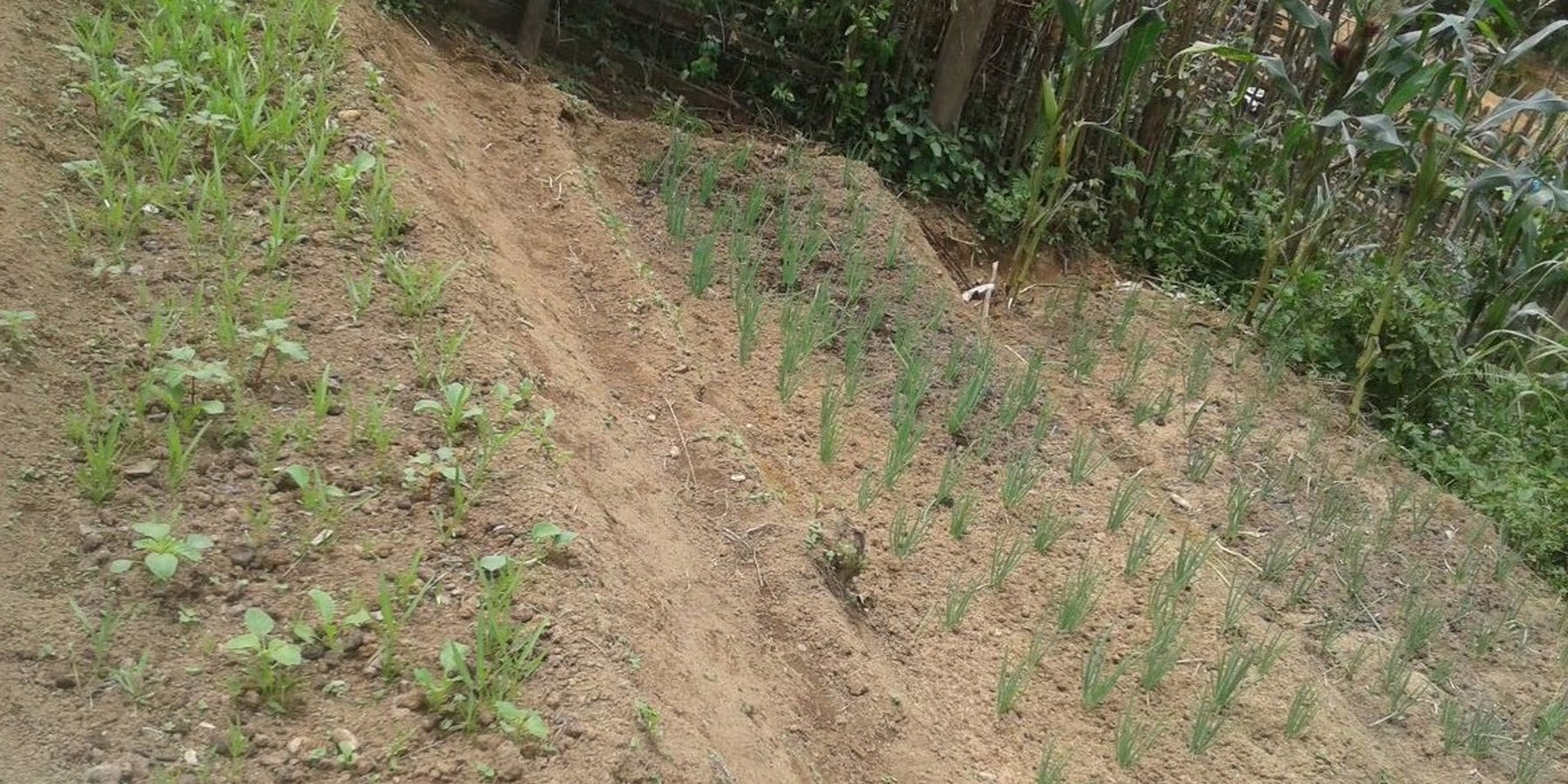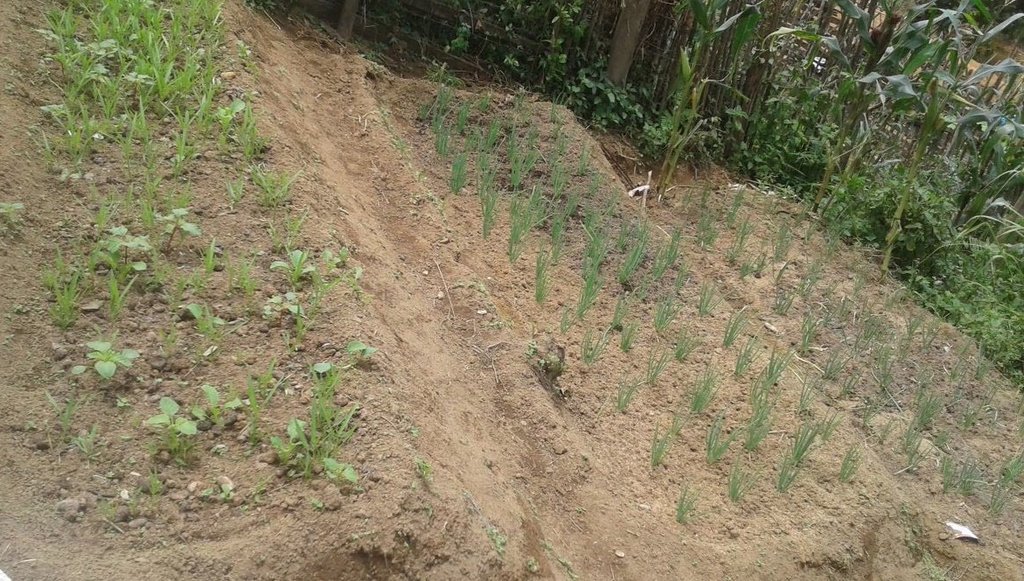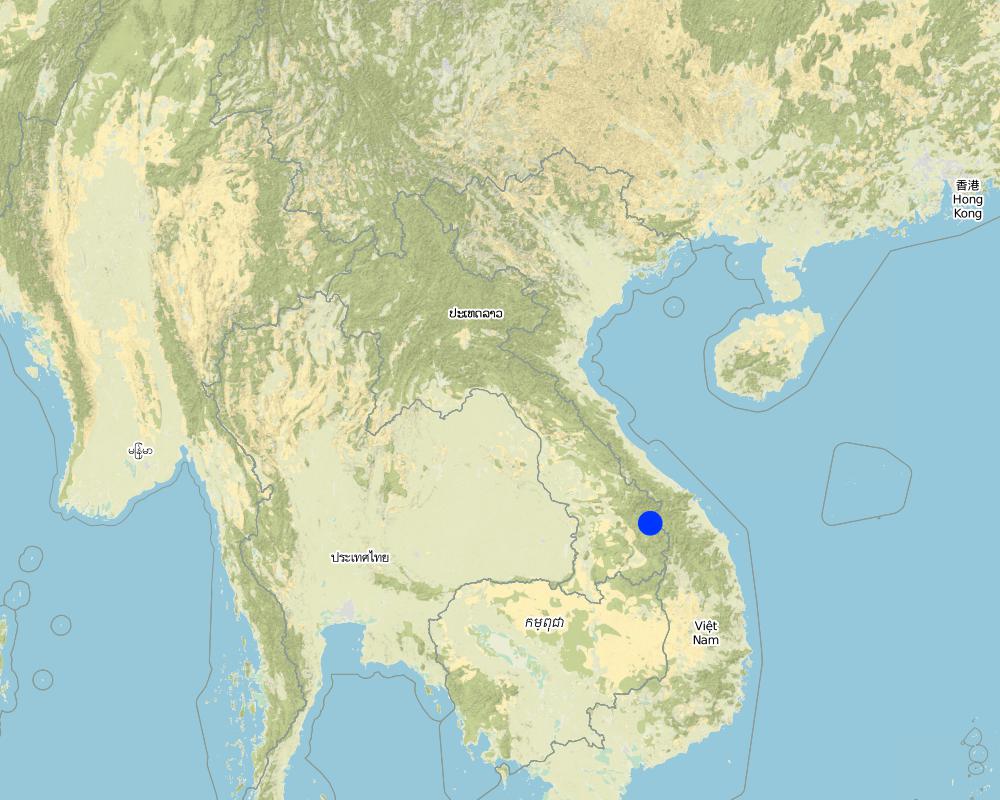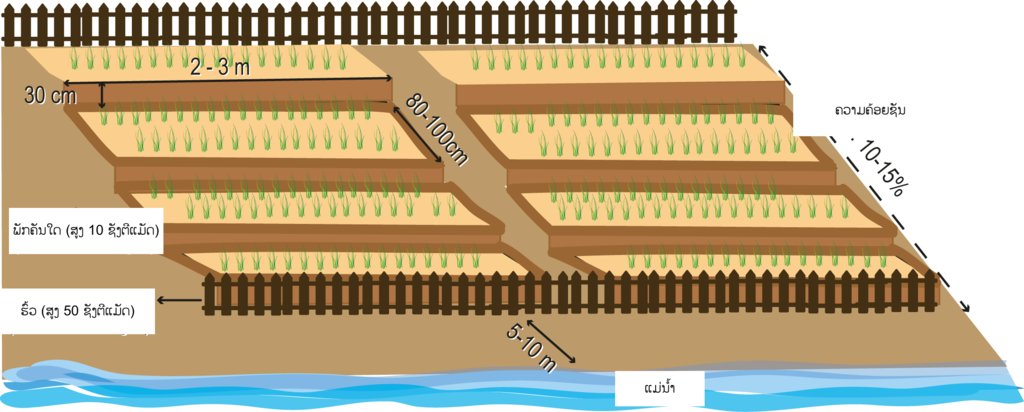Vegetable garden to improve vegetation cover in sloping land [Lao People's Democratic Republic]
- Creation:
- Update:
- Compiler: Khampheng Bounpanya
- Editors: Bounthanom Bouahom, kang phanvongsa, anousit namsena
- Reviewers: Nicole Harari, Nivong Sipaseuth, Stephanie Jaquet, Alexandra Gavilano
technologies_3139 - Lao People's Democratic Republic
View sections
Expand all Collapse all1. General information
1.2 Contact details of resource persons and institutions involved in the assessment and documentation of the Technology
Key resource person(s)
land user:
Homsamone
Lao People's Democratic Republic
Name of project which facilitated the documentation/ evaluation of the Technology (if relevant)
Scaling-up SLM practices by smallholder farmers (IFAD)Name of the institution(s) which facilitated the documentation/ evaluation of the Technology (if relevant)
National Agriculture and Forestry Research Institute (NAFRI) - Lao People's Democratic Republic1.3 Conditions regarding the use of data documented through WOCAT
The compiler and key resource person(s) accept the conditions regarding the use of data documented through WOCAT:
Yes
1.4 Declaration on sustainability of the described Technology
Is the Technology described here problematic with regard to land degradation, so that it cannot be declared a sustainable land management technology?
No
2. Description of the SLM Technology
2.1 Short description of the Technology
Definition of the Technology:
The technique involving the creation of vegetable home gardens on sloping land was initiated through the villagers’ local insight and it has been practiced over many generations. Due to the fact that the village is located on sloping land there are limitations regarding the availability of agricultural land suitable for growing vegetables in a home garden.
2.2 Detailed description of the Technology
Description:
The local farmers mainly grow vegetables with other crops such as upland rice in upland areas and vegetable home gardens. In addition, they grow also vegetables along riverbanks during the dry season. Land users living on mountainous areas typically grow vegetables during the wet season and some manage to cultivate them during dry season if appropriate land is available along streams and river banks. Vegetables have traditionally been cultivated by farmers in Darkchung district on terraced fields for many generations. However, growing vegetables on areas of land with a higher gradient (rolling slopes: 11-15%) has a number of restrictions, namely the lack of suitable land available and the limited water supply. As a result of these restrictions on land and water farmers have developed their own initiatives to enable the cultivation of vegetables on sloping land both for household consumption and for sale. The vegetables most commonly grown are coriander, morning glory, and Chinese cabbage and mustard leaf. In 2000 farmers expanded their vegetable gardens on slopes by preparing and cultivating the land manually. Suitable land for such vegetable gardens can be selected along the lower banks of a stream (there should be a distance of approximately 5 – 10 meters from the river to the vegetable plots). Firstly, grass has to be removed prior to ploughing the soil manually. Then the soil from the top part of the land should be transferred to the bottom to result in a levelling effect so that a relatively flat garden bed is created. The preparation process to develop the whole garden takes about 3 – 4 weeks and requires a team of two to three people. In the preparation process there is a distinctive drawback when the farmers remove the humus and topsoil from the upper section of the field and leave the less fertile subsoil behind. As a result, this might affect the productivity during the early stage of vegetable growth; and on the contrary the lower sections piled with nutritious topsoil from the upper parts become more suitable for plant growth. To solve this problem, the farmers shape and level the nutrient-rich topsoil up to 3-4 small terraces top down. On average, with an area of 0.01ha such vegetable fields in Darkchung district are divided into small terraces with a width of 60 – 80 centimetres and a length of 2 – 3 metres (about 7 – 8 terraced plots per household, mostly two terrace arrangements in parallel). There is approximately a 30 cm difference between the levels of the upper to the next lower vegetable terrace. Once the land levelling has been completed, the farmers are then able to prepare the plots by firstly ploughing the soil and then letting it dry for 5 – 7 days. The next stage involves the use of wooden poles to break down bigger clods of earth. Then a small earth dike (10cm in hight) is pilled up around each terrace to protect furhter against soil erosion by water. Before starting the vegetable cultivation fencing is needed against animal entry. After this, they use a rake to adjust the plot’s surface. The benefits of this terracing method is to extend the cultivation of vegetables on stream river banks for the household consumption. Futhermore, the terracing method and the better soil cover lead to protection of the stream banks from erosion and sediment transport. However, this technique have some constraints as well beause it is difficult to level the surface of the soil in these areas particularly by removing soil from the upper sections to the lower sections of the terraces.
2.3 Photos of the Technology
2.5 Country/ region/ locations where the Technology has been applied and which are covered by this assessment
Country:
Lao People's Democratic Republic
Region/ State/ Province:
Xekong province
Further specification of location:
Darkchung district
Specify the spread of the Technology:
- evenly spread over an area
If precise area is not known, indicate approximate area covered:
- < 0.1 km2 (10 ha)
Map
×2.6 Date of implementation
If precise year is not known, indicate approximate date:
- 10-50 years ago
2.7 Introduction of the Technology
Specify how the Technology was introduced:
- as part of a traditional system (> 50 years)
3. Classification of the SLM Technology
3.1 Main purpose(s) of the Technology
- improve production
- reduce, prevent, restore land degradation
3.2 Current land use type(s) where the Technology is applied

Cropland
- Annual cropping
Annual cropping - Specify crops:
- seed crops - sesame, poppy, mustard, other
- vegetables - leafy vegetables (salads, cabbage, spinach, other)
Number of growing seasons per year:
- 3
Comments:
Main crops: Chinese mustard and cabbage
3.4 Water supply
other (e.g. post-flooding):
- Water from stream
3.5 SLM group to which the Technology belongs
- improved ground/ vegetation cover
- cross-slope measure
- home gardens
3.6 SLM measures comprising the Technology

agronomic measures
- A1: Vegetation/ soil cover

structural measures
- S1: Terraces
3.7 Main types of land degradation addressed by the Technology

soil erosion by water
- Wt: loss of topsoil/ surface erosion
- Wg: gully erosion/ gullying

biological degradation
- Bc: reduction of vegetation cover
3.8 Prevention, reduction, or restoration of land degradation
Specify the goal of the Technology with regard to land degradation:
- prevent land degradation
4. Technical specifications, implementation activities, inputs, and costs
4.1 Technical drawing of the Technology
Technical specifications (related to technical drawing):
The average gradient for vegetable cultivation in terrain ranges from 10 – 15% and the distance from the stream to the vegetable plots is approximately 5 metres. The width of the average plot is about 80 – 100 cm, and the length is 2 -3 metres with the difference in height between the upper and the next lower terrace is about 30 cm. Fencing around the vegetable plot is needed to prevent damages done by animals (goats, cows etc.)
Author:
U.Gaemperli
Date:
5/6/2019
4.2 General information regarding the calculation of inputs and costs
Specify how costs and inputs were calculated:
- per Technology area
Indicate size and area unit:
200 Square meters
If using a local area unit, indicate conversion factor to one hectare (e.g. 1 ha = 2.47 acres): 1 ha =:
0,02 Hectare
other/ national currency (specify):
LAK
If relevant, indicate exchange rate from USD to local currency (e.g. 1 USD = 79.9 Brazilian Real): 1 USD =:
8000.0
Indicate average wage cost of hired labour per day:
30000
4.3 Establishment activities
| Activity | Timing (season) | |
|---|---|---|
| 1. | Land preparation (ploughing and levelling into terraces) | Before rainy season |
| 2. | Fencing | Before vegetable planting |
4.4 Costs and inputs needed for establishment
| Specify input | Unit | Quantity | Costs per Unit | Total costs per input | % of costs borne by land users | |
|---|---|---|---|---|---|---|
| Labour | Labour for land ploughing and levelling | person day | 21.0 | 30000.0 | 630000.0 | 100.0 |
| Labour | Labour for fencing | person day | 4.0 | 30000.0 | 120000.0 | 100.0 |
| Equipment | Shovel | piece | 2.0 | 100000.0 | 200000.0 | 100.0 |
| Equipment | Digger tool | piece | 2.0 | 100000.0 | 200000.0 | 100.0 |
| Construction material | Nails | kg | 2.0 | 10000.0 | 20000.0 | 100.0 |
| Construction material | Wire | roll | 2.0 | 60000.0 | 120000.0 | 100.0 |
| Construction material | Wooden posts | piece | 80.0 | 5000.0 | 400000.0 | 100.0 |
| Construction material | Wooden plank | piece | 20.0 | 5000.0 | 100000.0 | 100.0 |
| Construction material | Bamboo | piece | 300.0 | 2000.0 | 600000.0 | 100.0 |
| Total costs for establishment of the Technology | 2390000.0 | |||||
| Total costs for establishment of the Technology in USD | 298.75 | |||||
4.5 Maintenance/ recurrent activities
| Activity | Timing/ frequency | |
|---|---|---|
| 1. | Reshaping of the the terraces (maintenance of terraces) | After harvesting |
| 2. | Planting of seedling | After land preparation |
| 3. | Weeding | From time to time |
| 4. | Manure | From time to time |
4.6 Costs and inputs needed for maintenance/ recurrent activities (per year)
| Specify input | Unit | Quantity | Costs per Unit | Total costs per input | % of costs borne by land users | |
|---|---|---|---|---|---|---|
| Labour | Labour for re-levelling the terraces | person day | 4.0 | 30000.0 | 120000.0 | 100.0 |
| Labour | Labour for weeding | person day | 3.0 | 30000.0 | 90000.0 | 100.0 |
| Labour | Labour to apply manure | person day | 1.0 | 30000.0 | 30000.0 | 100.0 |
| Labour | Labour for planting | person day | 3.0 | 30000.0 | 90000.0 | 100.0 |
| Plant material | Seedling | bag | 4.0 | 5000.0 | 20000.0 | 100.0 |
| Fertilizers and biocides | Manure | kg | 30.0 | 5000.0 | 150000.0 | 100.0 |
| Total costs for maintenance of the Technology | 500000.0 | |||||
| Total costs for maintenance of the Technology in USD | 62.5 | |||||
4.7 Most important factors affecting the costs
Describe the most determinate factors affecting the costs:
The labour for land levelling is the most important factor affecting the costs.
5. Natural and human environment
5.1 Climate
Annual rainfall
- < 250 mm
- 251-500 mm
- 501-750 mm
- 751-1,000 mm
- 1,001-1,500 mm
- 1,501-2,000 mm
- 2,001-3,000 mm
- 3,001-4,000 mm
- > 4,000 mm
Indicate the name of the reference meteorological station considered:
Darkchung meteorological station
Agro-climatic zone
- humid
5.2 Topography
Slopes on average:
- flat (0-2%)
- gentle (3-5%)
- moderate (6-10%)
- rolling (11-15%)
- hilly (16-30%)
- steep (31-60%)
- very steep (>60%)
Landforms:
- plateau/plains
- ridges
- mountain slopes
- hill slopes
- footslopes
- valley floors
Altitudinal zone:
- 0-100 m a.s.l.
- 101-500 m a.s.l.
- 501-1,000 m a.s.l.
- 1,001-1,500 m a.s.l.
- 1,501-2,000 m a.s.l.
- 2,001-2,500 m a.s.l.
- 2,501-3,000 m a.s.l.
- 3,001-4,000 m a.s.l.
- > 4,000 m a.s.l.
Indicate if the Technology is specifically applied in:
- convex situations
5.3 Soils
Soil depth on average:
- very shallow (0-20 cm)
- shallow (21-50 cm)
- moderately deep (51-80 cm)
- deep (81-120 cm)
- very deep (> 120 cm)
Soil texture (topsoil):
- coarse/ light (sandy)
- medium (loamy, silty)
Soil texture (> 20 cm below surface):
- medium (loamy, silty)
Topsoil organic matter:
- medium (1-3%)
5.4 Water availability and quality
Ground water table:
< 5 m
Availability of surface water:
good
Water quality (untreated):
for agricultural use only (irrigation)
Is water salinity a problem?
No
Is flooding of the area occurring?
No
5.5 Biodiversity
Species diversity:
- medium
Habitat diversity:
- medium
5.6 Characteristics of land users applying the Technology
Sedentary or nomadic:
- Sedentary
Market orientation of production system:
- mixed (subsistence/ commercial)
Off-farm income:
- less than 10% of all income
Relative level of wealth:
- average
Individuals or groups:
- individual/ household
Level of mechanization:
- manual work
Gender:
- women
Age of land users:
- youth
- middle-aged
5.7 Average area of land used by land users applying the Technology
- < 0.5 ha
- 0.5-1 ha
- 1-2 ha
- 2-5 ha
- 5-15 ha
- 15-50 ha
- 50-100 ha
- 100-500 ha
- 500-1,000 ha
- 1,000-10,000 ha
- > 10,000 ha
Is this considered small-, medium- or large-scale (referring to local context)?
- small-scale
5.8 Land ownership, land use rights, and water use rights
Land ownership:
- individual, titled
Land use rights:
- open access (unorganized)
Water use rights:
- open access (unorganized)
5.9 Access to services and infrastructure
health:
- poor
- moderate
- good
education:
- poor
- moderate
- good
technical assistance:
- poor
- moderate
- good
employment (e.g. off-farm):
- poor
- moderate
- good
markets:
- poor
- moderate
- good
energy:
- poor
- moderate
- good
roads and transport:
- poor
- moderate
- good
drinking water and sanitation:
- poor
- moderate
- good
financial services:
- poor
- moderate
- good
6. Impacts and concluding statements
6.1 On-site impacts the Technology has shown
Socio-economic impacts
Production
crop production
Comments/ specify:
Increase crop production
risk of production failure
Comments/ specify:
Lower risk of flooding compared to other areas of vegetable gardens located in the lower plains.
product diversity
Comments/ specify:
Increase and diversification of vegetable production from their own vegetable home gardens due to enlargement of production area.
production area
Quantity before SLM:
0.02 ha
Quantity after SLM:
0.04 ha
land management
Comments/ specify:
As the land users use sloping land on river banks nearer to the village by shaping the land into terraces the land management for vegetable gardens has been simplified compared to the collection of wild vegetable on sloping forest area far away from the village.
Income and costs
farm income
Comments/ specify:
Before the farmers mainly produced for their home consumption. After: The vegetable production increased substantially to a level it can be also sold at the local market.
diversity of income sources
Comments/ specify:
The new option to sell vegetables at the local market diversified the income sources.
workload
Comments/ specify:
Workload decreased mainly for women as they do not have to spent time anymore to collect wild vegetables in the broad upland forest.
Socio-cultural impacts
situation of socially and economically disadvantaged groups
Comments/ specify:
Women benefit from this technology and it reduces the women's workload to collect vegetable from forest.
Ecological impacts
Soil
soil loss
Comments/ specify:
Protect stream banks from soil erosion by rain water.
Biodiversity: vegetation, animals
Vegetation cover
Comments/ specify:
Increased vegetation cover by the vegetable plantation. Before it was fallow covered with scarce grass vegetation.
6.2 Off-site impacts the Technology has shown
buffering/ filtering capacity
Comments/ specify:
Less sediment transportation due to improved vegetation cover in the slope areas of the river banks.
6.4 Cost-benefit analysis
How do the benefits compare with the establishment costs (from land users’ perspective)?
Short-term returns:
neutral/ balanced
Long-term returns:
positive
How do the benefits compare with the maintenance/ recurrent costs (from land users' perspective)?
Short-term returns:
neutral/ balanced
Long-term returns:
positive
6.5 Adoption of the Technology
- 11-50%
Of all those who have adopted the Technology, how many did so spontaneously, i.e. without receiving any material incentives/ payments?
- 91-100%
6.6 Adaptation
Has the Technology been modified recently to adapt to changing conditions?
No
6.7 Strengths/ advantages/ opportunities of the Technology
| Strengths/ advantages/ opportunities in the land user’s view |
|---|
| Lower risk of flooding in relation to other vegetable fields which are located in the lower plains. |
| Vegetable cultivation generates an income as well as provides food for farmers. |
| Gardening is an activity which women can actively and fully become involved in as it can be implemented in the village. |
6.8 Weaknesses/ disadvantages/ risks of the Technology and ways of overcoming them
| Weaknesses/ disadvantages/ risks in the land user’s view | How can they be overcome? |
|---|---|
| Vegetables require fertilizers to improve the yield. | Farmers also need to collect timber as building material to support the earth terraces so that fertilizer can be retained within the field. |
| Establishing and maintaining vegetable production is time consuming as it includes a number of activities such as land levelling, fertilizing, and the construction of fencing to prevent animal entry. | It also requires other equipment and tools for fencing. |
| Suitable land is limited due to mountainous terrains. |
| Weaknesses/ disadvantages/ risks in the compiler’s or other key resource person’s view | How can they be overcome? |
|---|---|
| The site selection for establishment. | This technique will establish in slopes area (less than 15% of slop) and the plots are located approximately 5 meters from the river/stream in order to avoid soil erosion. |
| Land preparation and land levelling – farmers mainly remove top soil from upper to lower section to level the plots. | People will remove soil from the upper to the lower sections of the plots in order to level them. Topsoil may have to be temporarily stockpiled somewhere so that it can be used as backfill where it is needed as the topsoil is more fertile and thus more productive. |
7. References and links
7.1 Methods/ sources of information
- field visits, field surveys
1
- interviews with land users
1
When were the data compiled (in the field)?
28/08/2017
Links and modules
Expand all Collapse allLinks
No links
Modules
No modules





